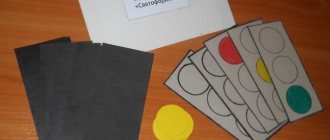Summary of a lesson on familiarization with the outside world in the preparatory group on the topic: Insects
Summary of a lesson on familiarization with the outside world in the preparatory group on the topic: “Insects.”
Author: Marina Mikhailovna Platnova, teacher, Moscow State Budgetary Educational Institution “School No. 285 named after V.A. Molodtsova" structural unit No. 14. Description of the material: I bring to your attention a summary of a lesson on speech development and familiarization with the outside world for children in the preparatory group of kindergarten. This methodological development may be useful for preschool teachers and parents. Goal: Expand and clarify children's knowledge about insects. Objectives: - To clarify children’s knowledge about insects (appearance, behavior in nature). — Develop dialogic monologue speech of children. — Cultivate a caring attitude towards insects. Material for the lesson: pictures of insects.
Progress of the lesson
-Guys, let's play the guessing game. - Guess the riddles. (Guessing pictures are put on the board). -From a branch to a path, from a path to a blade of grass. Is the spring jumping, the green back? ( Grasshopper)
-This Ivashka has a red shirt. Are there black dots on the back of the shirt? (Ladybug)
— The blue airplane landed on a yellow dandelion? (Dragonfly)
-It flutters and dances over the flower, waving its patterned fan. (Butterfly)
- Cheren, but not a raven, horned, but not a bull, six legs, but all without hooves? (Bug)
— It buzzes over the table, flies around, and really bothers everyone? (Fly)
- In the forest near the stump there is bustle, running around, people working all day long? (Ant)
- Ju-ju-ju! I'm buzzing over the flowers! I’ll work on the flower - Will I please you with honey? (Bee)
How can you call everyone in one word? That's right, insects. Insects are the most numerous and diverse class of the animal world. On land they live on all continents, with the exception of the Arctic and Antarctic. One of the characteristic differences between all insects is three pairs of legs (they are also called six-legged), so spiders, for example, do not belong to the class of insects. - At what time of year can we see them in nature? (Spring, summer, autumn). - Why are insects needed? (They pollinate plants and are food for birds and animals) - Guys, show me the body parts of insects.
(Head, antennae, proboscis, eyes, abdomen, wings, legs) - Tell us about the benefits insects bring. — To people: bees give honey and wax. — Forest: ants, ladybugs destroy harmful insects. — Birds and animals: insects serve as food. — Tell us about the harm insects cause. — For people: flies, cockroaches, mosquitoes bite painfully and spread dangerous diseases. — Forest: bark beetles damage the bark of trees, caterpillars eat the leaves of plants. — Animals and birds: mosquitoes, horseflies, fleas bite painfully. - Now let’s play the game “Call it affectionately” Komar-komarik. Dragonfly-... Cockroach-... Bug-... Bee-... Fly-... I explain to the children the concept of “predatory insects” (dragonfly, ant, ladybug, grasshopper). For example: a dragonfly feeds on mosquitoes and midges, which they grab on the fly like swallows. Large dragonflies can attack tadpoles and fish fry. — The most beautiful insects are butterflies. They live wherever there are plants. Butterflies can be large, even gigantic, the size of a bird, and small, the size of a fingernail. — Beetles live not only on land. The swimming beetle is a predatory beetle that can be found in almost every body of water. Swimming beetles attack insects that live in water, tadpoles and even fry of small fish. Their larvae are also predators. Having grabbed onto a tadpole or fish, they gradually eat part of the body of their victim, who drags the voracious bug along with her everywhere. — Flies and mosquitoes feed only on liquid food. Mosquito larvae live in water, while adult mosquitoes live in the air. The male mosquito is completely harmless; it feeds on plant sap and sweet nectar. Only females bite us. To lay eggs, they must drink blood. — Bees live in large families. A bee colony consists of one queen, who lays eggs, and several thousand worker bees. Each member of the colony performs its own duties: young bees clean the hive, build honeycombs, take care of the larvae, and then begin to fly out of the hive in search of pollen and nectar. - Ants also live in families in complex nests in the ground, under stones and in ground anthills, which they build from dry branches and pine needles. The family includes wingless working females, winged males and female founders (queens), who lay eggs and live for a very long time, up to 20 years. The main food for ants is other insects and plant seeds. — Guys, let's play the game “Give me a word.” — A dragonfly has eyes, not eyes. - The ant does not have legs, but... - The cockroach does not have a mustache, but... - The butterfly does not have a wing, but... - Has our lesson come to an end? — What types of insects do you remember? - Well done boys.
We recommend watching:
Summary of a lesson on speech development in the preparatory group. An environmental project in the senior group on the topic: Insects. An educational project in kindergarten “Insects” for children of the senior group. Synopsis of educational activities for children of the preparatory group in kindergarten with a presentation. Insects
Similar articles:
Lesson summary for the senior group on the topic: Insects and flowers
Poems about insects for preschool children 5-6 years old
Conversation about the caterpillar for children
About beetles for children 5-8 years old
About mosquitoes for children




